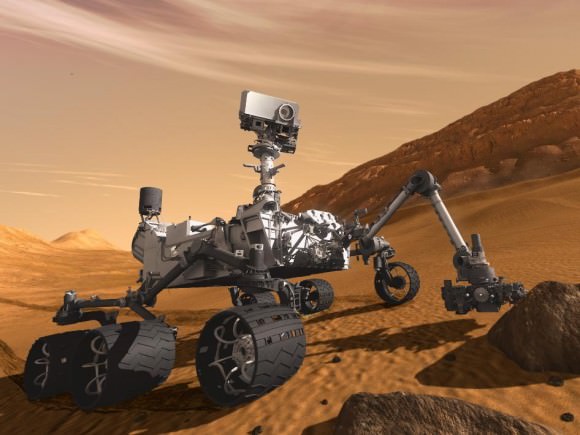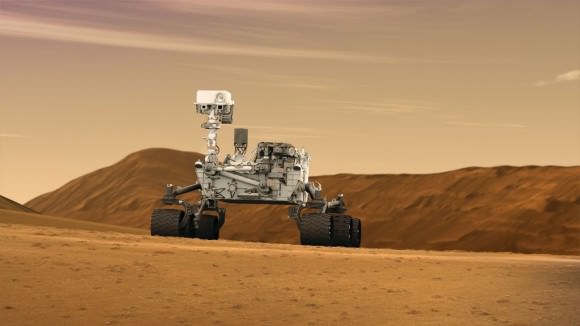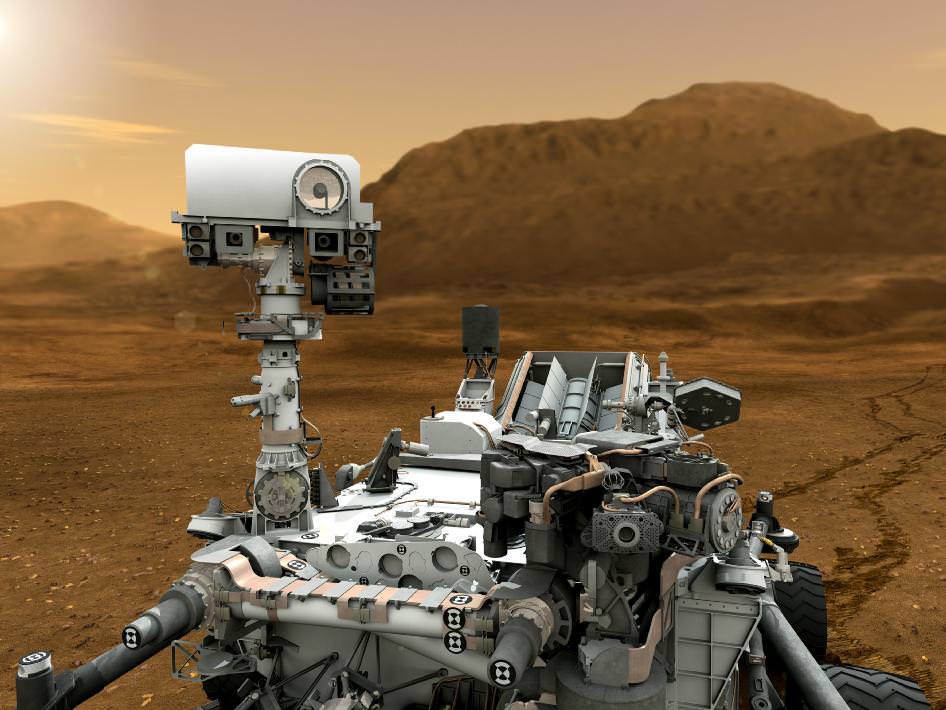[/caption]
NASA’s next Mars rover, the Curiosity Mars Science Laboratory, will soon embark on a quantum leap in humankind’s scientific exploration of the Martian surface -the most Earthlike planet in our Solar System.
To get a birds eye understanding of Curiosity’s magnificent capabilities, check out the dramatic new high resolution animation below which depicts NASA’s next Mars rover traversing tantalizing terrain for clues to whether Martian microbial life may have existed, evolved and been sustained in past or present times.
The new action packed animation is 11 minutes in length. It depicts sequences starting with Earth departure, smashing through the Martian atmosphere, the nail biting terror of the never before used rocket-backpack sky crane landing system and then progressing through the assorted science instrument capabilities that Curiosity will bring to bear during its minimum two year expedition across hitherto unseen and unexplored Martian landscapes, mountains and craters.
Curiosity is equipped with 10 science instruments. The three meter long robot is five times the weight of any previous Mars rover.
Those who closely follow the adventures of NASA’s Spirit and Opportunity rovers, like myself, will quickly recognize several of the panoramic scenes which have been included to give a realistic feeling of vistas to expect from the car sized Curiosity rover.
Here is a shorter 4 minute animation with expert narration
Along the way you’ll experience Curiosity zapping rocks with a laser, deftly maneuvering her robotic arm and camera mast and retrieving and analyzing Martian soil samples.
“It is a treat for the 2,000 or more people who have worked on the Mars Science Laboratory during the past eight years to watch these action scenes of the hardware the project has developed and assembled,” said Mars Science Laboratory Project Manager Pete Theisinger at NASA’s Jet Propulsion Laboratory, Pasadena, Calif, in a NASA statement. “The animation also provides an exciting view of this mission for any fan of adventure and exploration.”

Curiosity rover examines a rock on Mars with a set of tools at the end of the rover's arm, which extends about 2 meters (7 feet). Two instruments on the arm can study rocks up close. Also, a drill can collect sample material from inside of rocks and a scoop can pick up samples of soil. The arm can sieve the samples and deliver fine powder to instruments inside the rover for thorough analysis. Credit: NASA/JPL-Caltech
Curiosity was flown this week from her birthplace at NASA’s Jet Propulsion Laboratory in California to her future launch site in Florida aboard a C-17 military cargo transport aircraft.
She arrived at the Shuttle Landing Facility (SLF) at the Kennedy Space Center on June 22. The SLF is the same landing strip where I watched the STS-135 crew arrive for NASA’s final shuttle mission just days earlier days for their final launch countdown training.
NASA has scheduled Curiosity to blast off for the red planet on Nov. 25, 2011 from Cape Canaveral Air Force Station aboard an Atlas V rocket. Curiosity will touchdown in August 2012 at a landing site that will be announced soon by Ed Weiler, NASA Associate Administrator for the Science Mission Directorate in Washington, D.C.

Read my prior features about Curiosity
Packing a Mars Rover for the Trip to Florida; Time Lapse Video
Test Roving NASA’s Curiosity on Earth
Curiosity Mars Rover Almost Complete
Curiosity Rover Testing in Harsh Mars-like Environment


Awesome little video.
I’m still loving the rocket crane. It’s a great conversation piece to mention the next rover will land with the use of a rocket crane. ^_^
I think I stopped breathing during the landing sequence. Hopefully, the engineers who worked on this rover will survive the real entry.
I think I stopped breathing during the landing sequence. Hopefully, the engineers who worked on this rover will survive the real entry.
I think the worst part about that would be the lack of real-time information about how the landing is going. Nobody will really know if the retrorocket / crane setup actually worked until they get some data back from it around four and a half minutes later. By then, either it worked and landed … or it becomes another Mars Polar Lander and smashes into the red planet’s face.
I really, really hope this works … particularly after the incredible success stories of Spirit and Opportunity.
The light-time delay is irrelevant. When the radio-signals reach Earth, it feels real time. That’s how I felt when I watched the Phoenix landing ‘live.’ It may have either landed or crashed before I even turned on the TV. The signals are our perceptions and that is all we know. Either way, intervention is impossible due to the distances. That’s why landing is automatic.
We all seem to forget how similar Skycrane is to the system which safely landed Pathfinder, Spirit, and Opportunity. The latter had hair-raising rockets and cables, too. This new system builds upon that method, by combining hydrazine rocket packs used in Viking, and Phoenix for higher payload capacity, greater accuracy, and softer landing.
“Either way, intervention is impossible due to the distances. That’s why landing is automatic”
And that’s why the light-time delay is relevant. Keep in mind that in addition to the complex landing sequence that human eyes can’t directly oversee, there can’t be complete certainty about the terrain below. A pilot (present, or close enough for virtually immediate remote response) would have some leeway for selecting the most acceptable spot
One of the Viking landers came down not far from a large boulder that would have easily tipped it over, and to which its radar altimeter was blind. Apollo 11’s lander was approaching a ‘football field sized crater full of boulders’ that Neil Armstrong extended his approach to land beyond.
‘Automatic’ planetary landings are dicey enough, and now, a great deal more is being asked of automation, in literally the last minute of landing..
“The latter had hair-raising rockets and cables, too.”
That merely had to release at the right altitude, and hope for the best. Bouncing in on airbags after that, is rather less challenging than coming to a hover at a specific altitude on rocket exhaust, and steadily do so long enough to winch a payload gently to the ground, release on time, then move away as far as possible to impact, with no human intervention…
Not saying it can’t be done, but as I noted, it will be more of a nail-biter than usual.
The rocket crane is damn cool, but wow, what a great feat of engineering if that works!
too complicate for a landing…as usual what is too complicate will fail miserably. We all saw huge army tanks parachuted from plane no problem, why use this stupid complication for a much lighter vehicle? Martian athmosphere rare? Use more parachutes.
‘Use more parachutes’ is much easier said, than done.
http://www.universetoday.com/7024/the-mars-landing-approach-getting-large-payloads-to-the-surface-of-the-red-planet/
http://www.thespaceshow.com/detail.asp?q=1256
That’s what’s hard about landing on Mars, too much gravity for easy all-propulsive landing, not enough atmosphere for easy aerobraking of any kind. And it quickly gets harder with increasing landed mass. Those who whine about the idea of a Manned Mars mission that only goes to orbit and visits ts moons, then returns without landing, don’t realize how hard the last few hundred miles are, and that (not unlike Apollo 8) it’s worthwhile to do this, while a lander is still in development.
But having said that, the MSL approach also strikes me as very technically risky, especially for a device that can’t be controlled in ‘real time.’ If it doesn’t happen at a time that I’m working or sleeping, I’ll be doing more than the usual nail biting waiting for an indication that a successful landing has occurred…and knowing that speed of light delays being what they are, whatever the result, it’s already happened.
I don’t know that much about these systems in their detail. When you watch simulations of these parachutes deploying it is rather clear these are different than standard sky diving parachutes. They are more like aero-inflating braking shells. These operate at high velocity, not a drifting down sort of velocity. Further, it appears that since the Martian atmosphere is 1/100 the pressure on Earth that a parachute for complete descent would be impossibly large. The gravity is too large for a fuel economy powered landing.
The crane approach does strike me as overly complex. I am not sure why the whole gemish can’t be lowered to the surface, and the rover then drives off a ramp
LC
Nice pessimism, Mr. Happy…
To add to the problems of parachutes mentioned already, all else equal they are penalized by the idea that bacterial cross contamination is a problem. Personally I don’t think it is, endogenous life would always have a leg up any putative exogenous competition, but there it is.
Martian parachutes are IIRC the main bacterial source compared to the insides of the crafts they carry, unless my rough estimate is in error. (I made it somewhere on UT one of the times the topic was up.) Parachutes are cleaned to lower bacterial densities/area than the sensitive insides, but their immense area makes up for that.
Once the rover is safely landed, why don’t they crash land the rocket pod at high velocity back into mars, fairly close by so that the rover can reach it with ease. I’m quite sure it would leave a scar on the ground exposing a bit more of the martian soil than the puny little drill attached. Who knows what they might unearth(or unmars?). Awesome video.
The rocket pod is transported away from the landing area to avoid contamination of the region of interest by materials that make up the pod. Not biological contamination, but material contamination. We wouldn’t want to analyze surface material contaminated with pieces of the vehicle that got us there.
For that same reason, the Galileo Orbiter was sent into Jupiter’s atmosphere for destruction at the end of its mission. That way, it wouldn’t inadvertently contaminate a moon that we may wish to investigate in the future.
Likewise, the Deep Impact impactor that created a crater and plume on Comet Tempel 1 was made mainly of copper. Subsequent analysis of the plume and exposed material at the impact site could process out the copper, which is unlikely to occur in any abundance in the comet material, so any remains of the impactor could be “subtracted out”.
I think they should have designed the pod stage to do a controlled landing and stuck some experiments on there. There is a complete second set of backup rocket engines so if the primary engines work there should be plenty of fuel for a controlled touchdown at a safe distance away from Curiosity. I understand that for weight reasons you couldn’t have a complete science package like Phoenix but maybe there are some simple experiments that it could do. One example that comes to mind is making rocket fuel from martian soil. I have heard it tossed around that future manned missions would make the return fuel from the soil so that the landing craft wouldn’t be burdened with all that additional weight. It seems like they could put a mini “factory” on the pod stage that could do some experiments with martian fuel. short term experiments so they wouldn’t have to design the pod to survive winter.
Where does Curiosity get its electrical power to drive everything? I don’t see any solar panels. Is there some kind of nuclear powerplant on board?
Plutonium reactor, yes.
It’s called a Radioactive Thermoelectric Generator (RTG), and has been used on countless spacecraft. To name a few: Pioneer 10 and 11, Voyager 1 and 2, Viking Landers 1 and 2, Galileo Orbiter, Cassini Orbiter, New Horizons, Ulysses, Apollo 12 – 17 ALSEP (Apollo Lunar Surface Experiments Package).
See this Wikipedia article: http://en.wikipedia.org/wiki/Radioisotope_thermoelectric_generator
Very interesting. That landing looks very complex. Yikes. Makes one wonder why a simpler way couldn’t have been found.
Pet peeve alert!
When will animators/Hollywood stop putting sound in space? It’s so distracting to hear sounds when I shouldn’t.
The sky crane technique scares me too. I had the same reflexion about sounds in space. They should watch: 2001 A Space Odyssey to understand 🙂
my undderstanding is the sky crane method is being used because of Curiosities weight. It’s to heavy for the airbag method of the other rovers and they didn’t want Curiosity to be hampered by all the wieght of the descent engines once it was on the ground. It is extremely complicated. so many ways for the to go wrong. you can see in the animation that the descent stage has a backup rocket for each rocket.
Sounds such as rockets firing, explosive bolts detaching, sections detaching, would not be heard in the near vacuum of space. However, I was on hand for the development of the MER video, and the choice was made to include sounds as though there was a microphone attached to the spacecraft, which would pick up mechanical vibrations rather than propagated sound waves in nonexistent air.
There’s a video of a shuttle launch in which a camera with audio was attached to one of the solid rocket boosters (srb), and the raw footage contains audio from before srb separation, through descent, parachute deployment, to splashdown, so it’s not inconceivable that a mic could be attached to a spacecraft. The only technical consideration would be the added mass.
Link to SRB video – it’s not the highest resolution, but it is what I saw on immediate playback on NASA TV right after launch: http://www.youtube.com/watch?v=_4CCDW_GDd4.
Interesting story about NASA animation. Something which is very interesting in this era. Is there is anywhere on the internet a CGI animation of what suppose to happen with the impact on the moon??cause the real thing we couldn’t see anything.
http://www.zimbio.com/member/damianfrmn/articles/L-WcactAWkC/Fibra+Detox+Review+Get+Free+Trial+Now
SPAM ALERT!
Thanks, that comment has been snuffed out.
Thanks, that comment has been snuffed out.
I wonder what all they’ve done with Curiosity to overcome the problems of Spirit and Oppertunity. Obviously by changing to onboard power rather than solar, Curiousity doesn’t have to worry about the dust problems and can continue throughout the Martian winter, but what else have they done? its still a 6 wheeled design like the other rovers. What will Curiousity do if it gets stuck?
I believe they have put more margins on the mechanical parts. For example, IIRC despite larger wheels the speed will be much the same as for the smaller rovers. (Though it was a while since I checked into that, so I may be mistaken.)
I’m sure they have used lessons learned, since the RTG have 14 years at nominal power (~ 70 % initial power), and the electronics should live long too. Wouldn’t want to waste that!
A brilliant bit a hardware!